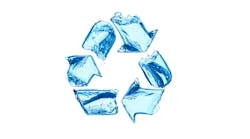Q: We have a home that uses well water. After replacing the water heater we had a terrible rotten egg odor in the hot water. The heater we replaced never had any odor problems. The plumber who installed the water heater came out and flushed the system with chlorine. But, after a short period the problem returned. The plumber returned and, explaining that the anode rod was probably causing a chemical reaction, removed it. The water heater supplier notified us that this voided our warranty. At that point we didn”t care as long as we did not have the odor … but it remained.
So, we hired another plumber who told us our water softener pump wasn”t working properly. He replaced the pump and the problem decreased but we still have some rotten egg odor.
Our system also has a water filter that uses potassium permanganate.
Do you think the water filter needs to be “recharged” with potassium permanganate? I have read that potassium permanganate will remove rotten egg smell from well water. The water also has started to leave a brown stain in the sinks and toilets.
— Virginia
A: It doesn”t make sense that the new water heater would produce the odor and the old one did not. If there is a rotten egg odor in only your hot water then the problem is, at least partly, in the heater. The usual cause is a combination of high sulfate in the well water, sulfate-reducing bacteria, the heat from the water heater and the typical magnesium anode rod in the heater. This forms the odorous rotten egg gas, hydrogen sulfide (H2S). The normal correction is to remove the “mag” rod entirely or replace it with one provided by the manufacturer of a different material, often an aluminum alloy or a “resistor” rod. The latter avoids the warranty issue and usually solves the odor problem. Your experience, therefore, is not explainable by the typical chemical and historical facts. Something else must be taking place.
I have never heard of a water softener pump so I cannot comment on this. Are you referring to a well pump?
There is apparently iron (Fe+2, Fe+3), manganese (MN+2, Mn+3) or H2S in the water, hence the need for a manganese greensand filter. This is what you refer to as requiring a potassium permanganate (KMnO4) regeneration. This type of filter should always precede a water softener, if present. This is a good filter medium if applied properly but has a relatively short lifespan, especially if the KMnO4 runs out or if a regeneration is late or skipped. In these cases the greensand must be replaced. Municipalities feed KMnO4 straight into the untreated water to remove H2S. The brown stain can be caused by iron or hydrogen sulfide. The hydrogen sulfide stains are usually more toward black.
With this water I would recommend that you consult a water treatment dealer and not a plumber, unless the plumber has special training in water treatment.
Q: We recently drilled a 240-foot well. While we have good water volume, there is an issue with a high arsenic level, high TDS, high sodium level and high pH. We are unable to use this water for anything except washing. It absolutely cannot be used for gardening because this water kills everything.
I”ve been searching for a solution and am confused by the many companies offering RO, electrodeionization, filtration, etc. I would like to be able to use our water to garden, drink, make ice, wash cars, etc.
— New Mexico
A: You have sent your water analysis to me and indeed you have a very high TDS (reported as both 1,530 ppm and 2,547 ppm). Your arsenic (As) is reported as being 0.001 ppm. No distinction was made between As+3 and As+5. Your hardness is 88 ppm (5 gpg). As expected, you have a high sodium level … probably the difference between your TDS and your hardness. The pH is indeed high at 8.97.
I would recommend that you work closely with a highly qualified local water treatment dealer to treat this type of water.
Barring a closer analysis, I think there should be a reverse osmosis (RO) system with a pre-RO pressure boosting pump for whichever part of your usage, possibly the whole house, needs a lower TDS. The high TDS requires a high RO feedwater pressure. If the hardness is reported correctly I would not bother to pre-soften this water. The RO should do this without the fouling that would occur with harder water. Iron was not reported but, if present, it should be removed prior to the RO. The RO should also remove the arsenic of 0.001 ppm to 0.02 ppm. The EPA”s maximum level is 0.01 ppm for municipal water.
Your pH is indeed very high at 8.97. The EPA, in their secondary drinking water standards, has set the maximum pH at 8.5. The higher pH, I would guess, must taste a little like baking soda (sodium bicarbonate, NaHCO3).
I can only speculate that either the high pH or the high TDS makes the water unsuitable for plants. Since RO membranes reject a high percent of the mineral content (TDS) of water but allow gases such as CO2 to pass through with the treated water, the pH is reduced by virtue of removing alkalinity but not the acid producing gas, CO2, the pH will be reduced in the RO product water … maybe enough to not require other treatment.
Q: I have a 10- by 42-inch water softener. After it regenerates the water tastes salty and the brine tank has a lot of water in it. I have cleaned the injector screen but it did not help.
A: I don”t know if you are reporting the “normal” level of liquid in the brine tank or an “overfill” of water. Every brine tank is refilled with fresh water near the end of regeneration to dissolve enough salt for the next regeneration. The greater the refill the more water that can be softened before the next regeneration is required … within the range specified below. The harder the water the lower the volume of gallons that can be treated after each regeneration.
Your softener tank contains about 1.0 cubic feet of water softening cation exchange resin. Salt doses for this volume of resin should range from six to 15 pounds of salt per regeneration. This would calculate to be about two to five gallons of refill above the lowest level after the regeneration brine has been drawn out. If the brine tank is the common 18-inch diameter, it holds about one gallon per inch of height. If the water tastes salty after regeneration, either the brine tank is overfilling or the subsequent rinse volume (set by minutes) is too low.
David M. Bauman, CWS-VI, CI, CCO, is technical editor of Water Technology® and a water treatment consultant in Manitowoc, Wis. He received his B.A. from the University of Illinois in Industrial Design. He can be reached by email at: [email protected].
For past articles in this column and related articles, go to www.WaterTechOnline.com and enter keyword “Professor” in the search box. To pose a question to “Professor POU/POE,” go to www.watertechonline.com, click “Ask the Professor” and follow the instructions.

